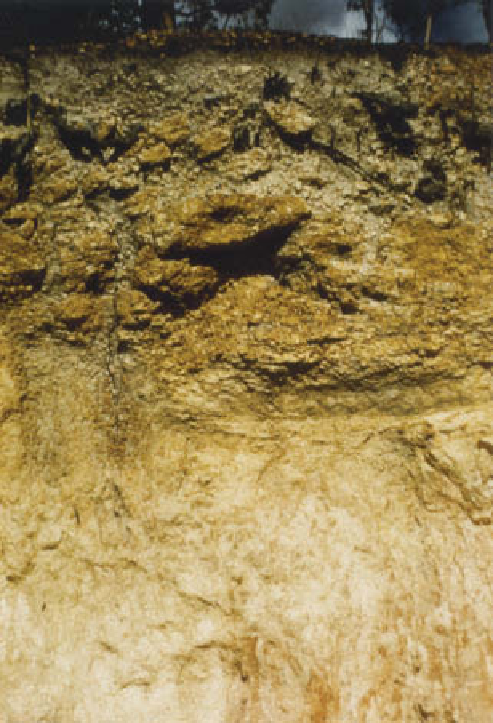Geoscience Reference
In-Depth Information
Pisolithic Ferralsol) in Western Australia. Section is 3 m.
Photo: E. A. FitzPatrick
manganese oxides, and gibbsite, found to a depth of 1.5 m in
the Western Australian soil.
Photo: E. A. FitzPatrick
mottled zone (Bgox) which undergoes alternate oxidation
and reduction due to the seasonal changes in the depth
of the water table. With depth the soil becomes paler
and paler, often becoming quite white. This is the pallid
horizon (Cg), a soft layer with rock structures often
preserved. It is the zone of permanent reducing conditions
and continues down to the weathering rock zone. Thus a
well developed lateritic soil (FAO: Ferralsol) will have
four distinct zones: a surface zone, a lateritic zone, a
mottled zone and a pallid zone. The lateritic and pallid
zones vary greatly in thickness spatially. The bright red
colours of lateritic soils are due to the presence of
haematite (Fe
2
O
3
) and goethite (FeO.OH) iron oxides;
in the pallid zone iron occurs as the hydrated iron
oxide lepidocrocite (FeO.OH) and as ferrous compounds
Intense leaching makes tropical lateritic soils deficient
in major and minor nutrient elements. Many elements are
simply removed from the soil profile, or bound up in an
unavailable form in the iron oxides (e.g. phosphate).
There has been some success in growing commercial crops
when fertilizer is applied, as in parts of Australia and
Africa. However, physical conditions are often difficult. In
the 1940s the Groundnut Scheme of the British govern-
ment unsuccessfully attempted to cultivate groundnuts
(peanuts) on tropical soil in Tanzania (then Tanganyika).
It was the induration of the soil structure which proved
to be the most difficult physical factor of soil fertility to
ameliorate. The gravelly, concretionary surface erodes
farm implements very quickly. In the Groundnut Scheme
it was found that a conventional set of discs would
last little more than a month! Lateritic soils are still very
much 'problem soils', but because they occur in Less
Developed Countries (LDCs) which are keen to improve
their agricultural productivity, there is pressure from











































